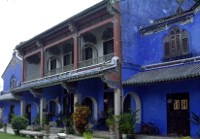Vacations in Georgetown Penang Island

Introduction to Georgetown Penang Island
Georgetown, once a British Colonial, was founded in 1786 by Sir Francis Lights from the British East India Company. Penang was originally an island belonging to Sultan (meaning King) from Kedah, but Sir Francis Light had managed to obtain it as his base for trading between the East and West. Fort Cornwallis was built as port of trading and the population and economy of Penang Island grew rapidly since then.
In the early 19th century, Beach street, Light Street, Chulia street and Weld Quay were the most populated areas. Trading were conducted here, Chinese and Indian immigrants lived around the areas. Hence, on July 7th 2007, these areas are classified as a UNESCO World Heritage Site by the World Heritage Committee in Quebec City, Canada. Buildings were constructed with a mixture of European, Malays and Chinese influences.
Accomodations in Penang
Many hotels and resorts are available in the Batu Ferringhi (northern coastline of Penang island) if you opt for beach vacations, or inner Georgetown if you are into cultural heritage and backpacking. A more centralized location for accommodation would be in Tanjung Tokong or Gurney area, which is the prime central of Penang Island.
Sights of Attractions in Penang
Clan Jetties is an unique settlement by Chinese Immigrants along Weld Quay since the 19th century. Home were built on the sea along wooden piers in according to the clans. There are 8 clans in total, dividing in accordance to Chinese Immigrant last name, Chew Jetty, Koay Jetty, Lim Jetty, Peng Aun Jetty, Lee Jetty, Tan Jetty, Yeoh Jetty and Mixed Clan Jetty. It reflects the unique historical and cultures of Chinese Immigrant settlement in Penang.
St. George’s Church was built in 1818 by convicts. This is one of the oldest landmark in the Penang Island. This church is named after the patron saint of England, and is also the memorial canopy of Sir Francis Light, who founded Penang in 1876.
 It’s unique design and collections of porcelain, sculptures and carvings has made Cheong Fatt Tze Mansion a popular tourist destination in Penang. In year 2000, this mansion earned an award from UNESCO Asia Pacific Heritage Awards for Culture Heritage Conservation as the ‘Most Excellent Project’.
It’s unique design and collections of porcelain, sculptures and carvings has made Cheong Fatt Tze Mansion a popular tourist destination in Penang. In year 2000, this mansion earned an award from UNESCO Asia Pacific Heritage Awards for Culture Heritage Conservation as the ‘Most Excellent Project’.
Kek Lok Si Temple is one of the finest Buddhist temples in Southeast Asia. This temple stands on a hill at Air Itam town. This temple boast a beautiful pagoda by the name of Ten Thousand Buddhas. This temple takes more than 20 years to build, and features shrines, sculptures, gardens and turtle pond. All lighting will be turn on during month of Chinese New Year (end January – February).
Snake temple is a temple built in around 1850 by a Chinese monk, dedicated to Cho Soo Kong who has miracle healing power. Legend had said that upon the completion of the temple, the snakes moved in and crawling freely in the temple.
Batu Ferringhi is the beautiful seaside district in Penang. Various choices of water sports, such as jet skiing, parachuting or sailing are available to meet your adventurers’ needs. If you opt for a more relax afternoon, you may stroll along the beach, watching sunset or best of all, getting a foot reflexology massage on the beach and sipping fresh coconut juice to quench your thirst.
At night, one can see Batu Ferringhi in another delight – the night market. It has transformed itself into a busy road side stalls, selling souvenirs such as pewter, wood carving, T-shirt, watches and local handicrafts. Restaurants, cafe and food center serving local delights and international food are packed with the locals and tourists.
Further up north from Batu Ferringhi is the fishing village Teluk Bahang. Teluk Bahang is famous for the seafood restaurant offering live, fresh seafood and as the entrance gate to the Penang National Park. Entrance to this forest reserve is free of charge but registration is required. The registration office, located near fishing boats will provides guides and maps to explore the forest. This forest reserve is rich with different types of habitats, namely the Monkey Beach, meromictic lake, coral reef, turtle nestling beaches. Animals such as wild boars, wild cats, sea otters, lizards, snakes and much more are commonly seen in this forest.
Fort Cornwallis was built on the site of Sir Francis Light’s historic landing in 1786. Originally a wooden stockade, it was replaced by a concrete structure built by convicts in 1804.
Goddess of Mercy Temple is one of the oldest Chinese temples in Penang. It was built in year 1800 by Chinese immigrants. This building is also known as Kuan Yin Ting. Many devotee Buddhist goes to temples for praying and blessing all year round, especially during Chinese New Year and its anniversary celebrations (Goddess of Mercy’s birthday).
Kapitan Keling Mosque was built in early 19th century. This mosque was named after an Indian Muslim merchant.
The City Hall building was built during the English Colonial period. There is an art Gallery resides in the building. Gallery Penang features prints of early days in Penang.
Khoo Kongsi was originally a house for Khoo family, a Chinese immigrant from South China in Khoo Kongsi 1898. It’s beams and ceiling are nicely embellished with stunning carvings in woods and stones.
Acheen Street Malay Mosque was built in 1820, on a piece of land donated by Syed Sheriff Tengku Syed Hussain Aidid . This mosque is also known as Masjid Melayu.
Pinang Peranakan Mansion is equipped with settings that tells the history and colorful lifestyle of the Baba (male) and Nyoya (female) (Straits Chinese) of Penang. Straits Chinese are descendent of a native Malay and a Chinese Immigrant. The mansion illustrates the culture of the straits, displaying Baba and Nyona traditional costumes and accessories, lovely porcelain, furnitures and arts.
The history of Sri Mariamman Temple can be traced back to 1883. The fascinating statue Lord Subramaniam in the temple is embellished with gold, silver, diamonds and emeralds. Sculpture of God and Goddess are standing in the font door greeting visitors.
Little India is where the first Indian temple, Sri Mahamariamman Temple was built in 1841. In the street of Little India, restaurants, jeweler, textile shops, spice shops, dress retailers (mostly Sari, the traditional Indian costume), sundries, barber are occupying the pre-war buildings in the area. It’s a great place to try the authentic Indian cuisine in Penang.
Penang Tropical Fruit Farm, heaven for fruit lover. Serving all you can eat tropical fruits, such as cempedak, mangosteen, Durian (seasonal, normally available in June and December) and so much more. Admission fee applies.
Gurney Drive is where the seafront shopping malls, Gurney Plaza and Gurney Paragon are located. At the end of Gurney Drive is the center for the famous Penang hawker food, which are often crowded with the locals and tourists.
Penang Hill is a great location to have a full view on Penang Island. At 830 meter high, the weather in hill top is much cooler as compared to city. There are two ways to reach the hill top, either by a cable car or to hire a four wheel drive car (Jeep). Penang Hill is located in Air Itam area, about 20 minutes from down town by car.